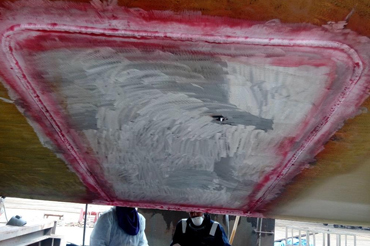DYE PENETRANT TESTING (LPT)
EIWAA Marine Services offers Weld Testing and welding inspection services by Non-destructive Testing Services by Rope Access Services or Normal Access Services in Saudi Arabia. All the weld surface NDT Inspection Services of Eddy Current Inspection Services and Magnetic Particle Testing shall be performed along with DPI Testing as supportive Services by EIWAA Marine Services. NDT Testing and Third Party NDT Services of Eddy Current Testing Inspection by Rope Access Services is different from other marine services in Saudi Arabia Ports and offshore industry.
Penetrant Testing (PT), also known as dye penetrant testing, is based on the capillary action that causes a liquid to rise when confined to a small opening and the surface wetting property. Our NDT Technicians are approved by ABS and BV to execute Penetrant Inspection on welding surface with a wide range of shapes, sizes, and materials, including
- Metals
- Composites
- Glass
- Ceramics
- Rubber
- Plastics
As a standard technique, the temperature of the penetrant and the surface of the part to be processed shall not be below40º degree F (5ºC) and not above 125º degree F (52ºC) throughout the examination period. Local heating and cooling are permitted provided the part temperature remains in the range of 40º degree F (5ºC) nor above 125º degree F (52ºC).Penetrant may be applied by dipping, brushing, or spraying. Filters shall be used on the upstream side of the air inlet when using compressed air to apply penetrant.The length of time the penetrant must remain on the part to allow proper penetration shall be as recommended by the penetrant manufacturer.
Procedure for Solvent-Removable Fluorescent Penetrant Examination
| Temperature Limit | 40° to 125°F (5°C to 52°C) | |
| Surface Conditioning Prior to Penetrant Inspection | As welded, cast, rolled, forged condition unless otherwise instructed. | |
| Pre clean | Approved solvent cleaner. Allow to dry minimum 5 minutes prior to proceeding with the test. | |
|
Penetrant Materials (Attachment V) |
PENETRANT | DEVELOPER |
| Solvent Removable Fluorescent |
Dry Developer Aqueous Developer Non-Aqueous Developer |
|
| Penetrant Application | Depending on whether penetrant is supplied in bulk containers or aerosol cans, application can be by dipping, brushing, flooding, or spraying. | |
| Penetrant Dwell Time | 10 to 20 minutes depending on defect sought per Table 1. | |
|
Excess Penetrant Removal |
Remove penetrant with a dry, clean, lint free cloth or paper towel, followed by moistened clean, lint free, white cloth or paper towel. For final removal of excess penetrant use a dry, lint free white cloth or paper towel. |
|
| Developer Application |
Spray at 250mm to 300mm (10″ to 12″) from the surface. If Aqueous (water based) developer is used, flood the surface and allow to dry. |
|
| Inspection Lighting |
Black Light – 1000 µW/cm² – 3000 µ W/cm² White Light – Maximum = 2 ftc |
|
| Post Cleaning | Wipe surface clean with dry cloth. Flush surface with an approved solvent cleaner. Wipe as required with a clean cloth and/or absorbent paper towel. | |

